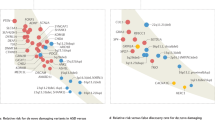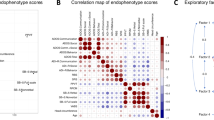Abstract
Autism, an entirely behavioral diagnosis with no largely understood etiologies and no population-wide biomarkers, contrasts with fragile X syndrome (FXS), a single-gene disorder with definite alterations of gene expression and neuronal morphology. Nevertheless, the behavioral overlap between autism and FXS suggests some overlapping mechanisms. Understanding how the single-gene alteration in FXS plays out within complex genetic and neural network processes may suggest targets for autism research and illustrate strategies for relating autism to more singular genetic syndromes.
This is a preview of subscription content, access via your institution
Access options
Subscribe to this journal
Receive 12 print issues and online access
$209.00 per year
only $17.42 per issue
Buy this article
- Purchase on Springer Link
- Instant access to full article PDF
Prices may be subject to local taxes which are calculated during checkout

Similar content being viewed by others
References
Belmonte, M.K. et al. Autism and abnormal development of brain connectivity. J. Neurosci. 24, 9228–9231 (2004).
Pieretti, M. et al. Absence of expression of the FMR-1 gene in fragile X syndrome. Cell 66, 817–822 (1991).
Weiler, I.J. et al. Fragile X mental retardation protein is translated near synapses in response to neurotransmitter activation. Proc. Natl. Acad. Sci. USA 94, 5395–5400 (1997).
Hagerman, R.J. The physical and behavioral phenotype. in Fragile X Syndrome: Diagnosis, Treatment, and Research 3rd edn. (eds. Hagerman, R.J. & Hagerman, P.J.) 3–109 (Johns Hopkins Univ. Press, Baltimore, 2002).
Feinstein, C. & Reiss, A.L. Autism: the point of view from fragile X studies. J. Autism Dev. Disord. 28, 393–405 (1998).
Sears, L.L. et al. An MRI study of the basal ganglia in autism. Prog. Neuropsychopharmacol. Biol. Psychiatry 23, 613–624 (1999).
Hollander, E. et al. Striatal volume on magnetic resonance imaging and repetitive behaviors in autism. Biol. Psychiatry 58, 226–232 (2005).
Reiss, A.L., Abrams, M.T., Greenlaw, R., Freund, L. & Denckla, M.B. Neurodevelopmental effects of the FMR-1 full mutation in humans. Nat. Med. 1, 159–167 (1995).
Eliez, S., Blasey, C.M., Freund, L.S., Hastie, T. & Reiss, A.L. Brain anatomy, gender and IQ in children and adolescents with fragile X syndrome. Brain 124, 1610–1618 (2001).
Courchesne, E. et al. Abnormality of cerebellar vermian lobules VI and VII in patients with infantile autism: identification of hypoplastic and hyperplastic subgroups with MR imaging. AJR Am. J. Roentgenol. 162, 123–130 (1994).
Kaufmann, W.E. et al. Specificity of cerebellar vermian abnormalities in autism: a quantitative magnetic resonance imaging study. J. Child Neurol. 18, 463–470 (2003).
Fu, Y.H. et al. Variation of the CGG repeat at the fragile X site results in genetic instability: resolution of the Sherman paradox. Cell 67, 1047–1058 (1991).
Filipek, P.A. Medical aspects of autism. in Handbook of Autism and Pervasive Developmental Disorders 3rd edn. (eds. Volkmar, F.R., Paul, R., Klin, A. & Cohen, D.) 534–578 (Wiley, Hoboken, New Jersey, 2005).
Rogers, S.J., Wehner, D.E. & Hagerman, R.J. The behavioral phenotype in fragile X: symptoms of autism in very young children with fragile X syndrome, idiopathic autism, and other developmental disorders. J. Dev. Behav. Pediatr. 22, 409–417 (2001).
Clifford, S. et al. Autism spectrum phenotype in males and females with fragile X full mutation and premutation. J. Autism Dev. Disord. (in the press).
Kaufmann, W.E. et al. Autism spectrum disorder in fragile X syndrome: communication, social interaction, and specific behaviors. Am. J. Med. Genet. A. 129, 225–234 (2004).
Hagerman, R.J. Lessons from fragile X regarding neurobiology, autism, and neurodegeneration. J. Dev. Behav. Pediatr. 27, 63–74 (2006).
Beckel-Mitchener, A. & Greenough, W.T. Correlates across the structural, functional, and molecular phenotypes of fragile X syndrome. Ment. Retard. Dev. Disabil. Res. Rev. 10, 53–59 (2004).
Bear, M.F., Huber, K.M. & Warren, S.T. The mGluR theory of fragile X mental retardation. Trends Neurosci. 27, 370–377 (2004).
Pickett, J. & London, E. The neuropathology of autism: a review. J. Neuropathol. Exp. Neurol. 64, 925–935 (2005).
Bauman, M.L. & Kemper, T.L. Neuroanatomic observations of the brain in autism: a review and future directions. Int. J. Dev. Neurosci. 23, 183–187 (2005).
Casanova, M.F., Buxhoeveden, D.P., Switala, A.E. & Roy, E. Minicolumnar pathology in autism. Neurology 58, 428–432 (2002).
Kogan, C.S. et al. Integrative cortical dysfunction and pervasive motion perception deficit in fragile X syndrome. Neurology 63, 1634–1639 (2004).
Bertone, A., Mottron, L., Jelenic, P. & Faubert, J. Enhanced and diminished visuo-spatial information processing in autism depends on stimulus complexity. Brain 128, 2430–2441 (2005).
Kogan, C.S. et al. Differential impact of the FMR1 gene on visual processing in fragile X syndrome. Brain 127, 591–601 (2004).
Pellicano, E., Gibson, L., Maybery, M., Durkin, K. & Badcock, D.R. Abnormal global processing along the dorsal visual pathway in autism: a possible mechanism for weak visuospatial coherence? Neuropsychologia 43, 1044–1053 (2005).
Johnson, M.H., Halit, H., Grice, S.J. & Karmiloff-Smith, A. Neuroimaging of typical and atypical development: a perspective from multiple levels of analysis. Dev. Psychopathol. 14, 521–536 (2002).
Kwiatkowski, D.J. & Manning, B.D. Tuberous sclerosis: a GAP at the crossroads of multiple signaling pathways. Hum. Mol. Genet. 14, R251–R258 (2005).
Basu, T.N. et al. Aberrant regulation of ras proteins in malignant tumour cells from type 1 neurofibromatosis patients. Nature 356, 713–715 (1992).
Costa, R.M. et al. Mechanism for the learning deficits in a mouse model of neurofibromatosis type 1. Nature 415, 526–530 (2002).
Butler, M.G. et al. Subset of individuals with autism spectrum disorders and extreme macrocephaly associated with germline PTEN tumour suppressor gene mutations. J. Med. Genet. 42, 318–321 (2005).
Kwon, C.H. et al. Pten regulates neuronal arborization and social interaction in mice. Neuron 50, 377–388 (2006).
Samaco, R.C., Hogart, A. & LaSalle, J.M. Epigenetic overlap in autism-spectrum neurodevelopmental disorders: MECP2 deficiency causes reduced expression of UBE3A and GABRB3. Hum. Mol. Genet. 14, 483–492 (2005).
Zoghbi, H.Y. Postnatal neurodevelopmental disorders: meeting at the synapse? Science 302, 826–830 (2003).
Jamain, S. et al. Mutations of the X-linked genes encoding neuroligins NLGN3 and NLGN4 are associated with autism. Nat. Genet. 34, 27–29 (2003).
Laumonnier, F. et al. X-linked mental retardation and autism are associated with a mutation in the NLGN4 gene, a member of the neuroligin family. Am. J. Hum. Genet. 74, 552–557 (2004).
Yan, J. et al. Analysis of the neuroligin 3 and 4 genes in autism and other neuropsychiatric patients. Mol. Psychiatry 10, 329–332 (2005).
Vincent, J.B. et al. Mutation screening of X-chromosomal neuroligin genes: no mutations in 196 autism probands. Am. J. Med. Genet. B Neuropsychiatr. Genet. 129B, 82–84 (2004).
Gauthier, J. et al. NLGN3/NLGN4 gene mutations are not responsible for autism in the Québec population. Am. J. Med. Genet. B Neuropsychiatr. Genet. 132, 74–75 (2005).
Ylisaukko-oja, T. et al. Analysis of four neuroligin genes as candidates for autism. Eur. J. Hum. Genet. 13, 1285–1292 (2005).
Blasi, F. et al. Absence of coding mutations in the X-linked genes neuroligin 3 and neuroligin 4 in individuals with autism from the IMGSAC collection. Am. J. Med. Genet. B Neuropsychiatr. Genet. 141, 220–221 (2006).
Comoletti, D. et al. The Arg451Cys-neuroligin-3 mutation associated with autism reveals a defect in protein processing. J. Neurosci. 24, 4889–4893 (2004).
Chih, B., Engelman, H. & Scheiffele, P. Control of excitatory and inhibitory synapse formation by neuroligins. Science 307, 1324–1328 (2005).
Todd, P.K., Mack, K.J. & Malter, J.S. The fragile X mental retardation protein is required for type-1 metabotropic glutamate receptor-dependent translation of PSD-95. Proc. Natl. Acad. Sci. USA 100, 14374–14378 (2003).
Rubenstein, J.L. & Merzenich, M.M. Model of autism: increased ratio of excitation/inhibition in key neural systems. Genes Brain Behav. 2, 255–267 (2003).
Devlin, B. et al. Autism and the serotonin transporter: the long and short of it. Mol. Psychiatry 10, 1110–1116 (2005).
Sutcliffe, J.S. et al. Allelic heterogeneity at the serotonin transporter locus (SLC6A4) confers susceptibility to autism and rigid-compulsive behaviors. Am. J. Hum. Genet. 77, 265–279 (2005).
Delorme, R. et al. Support for the association between the rare functional variant I425V of the serotonin transporter gene and susceptibility to obsessive compulsive disorder. Mol. Psychiatry 10, 1059–1061 (2005).
Persico, A.M. & Bourgeron, T. Searching for ways out of the autism maze: genetic, epigenetic, and environmental clues. Trends Neurosci. 29, 349–358 (2006).
Hollander, E., King, A., Delaney, K., Smith, C.J. & Silverman, J.M. Obsessive-compulsive behaviors in parents of multiplex autism families. Psychiatry Res. 117, 11–16 (2003).
Acknowledgements
We gratefully acknowledge all the people with autism spectrum conditions and their families who, by participating in our and others' studies, have generously contributed to the advancement of the autism field. T.B. is supported by Cure Autism Now, Fondation France Telecom, Fondation biomédicale de la mairie de Paris, AUMOLGEN FP6 and EUSynapse FP6.
Author information
Authors and Affiliations
Ethics declarations
Competing interests
The authors declare no competing financial interests.
Rights and permissions
About this article
Cite this article
Belmonte, M., Bourgeron, T. Fragile X syndrome and autism at the intersection of genetic and neural networks. Nat Neurosci 9, 1221–1225 (2006). https://doi.org/10.1038/nn1765
Published:
Issue Date:
DOI: https://doi.org/10.1038/nn1765
This article is cited by
-
Shank3 deletion in PV neurons is associated with abnormal behaviors and neuronal functions that are rescued by increasing GABAergic signaling
Molecular Autism (2023)
-
Screening for Fragile X Syndrome Among Filipino Children with Autism Spectrum Disorder
Journal of Autism and Developmental Disorders (2023)
-
Predictors, Parental Views, and Concordance Across Diagnostic Sources of Autism in Male Youth with Fragile X Syndrome: Clinical Best Estimate and Community Diagnoses
Research on Child and Adolescent Psychopathology (2023)
-
Roles of neuroligins in central nervous system development: focus on glial neuroligins and neuron neuroligins
Journal of Translational Medicine (2022)
-
Neurogenetic disorders across the lifespan: from aberrant development to degeneration
Nature Reviews Neurology (2022)



